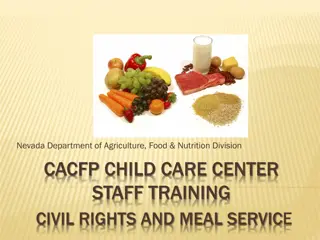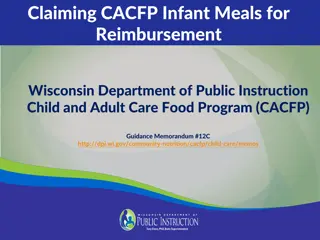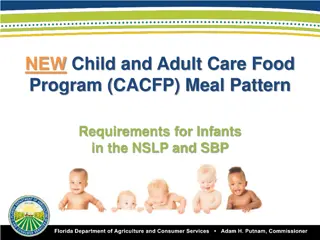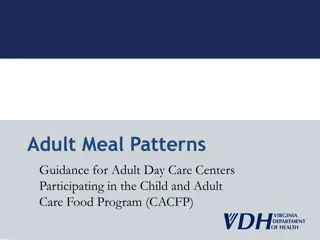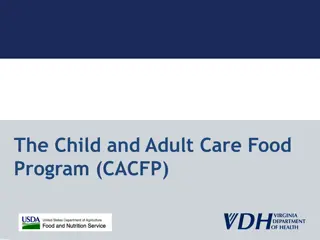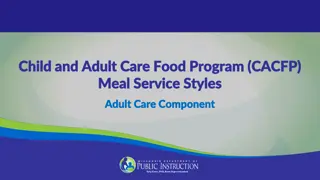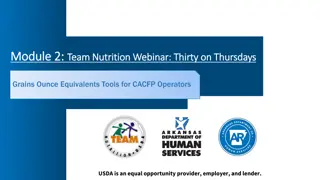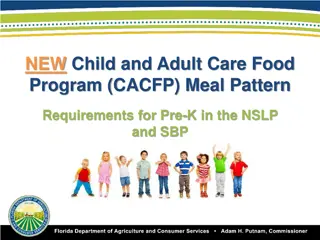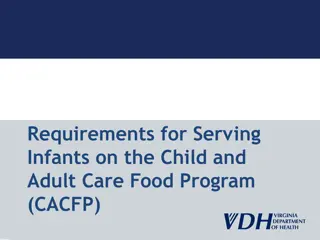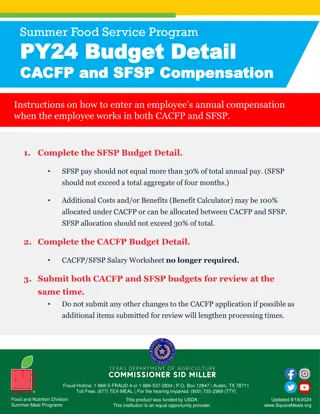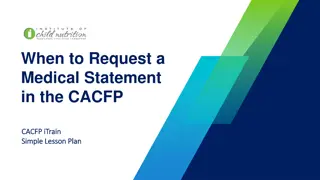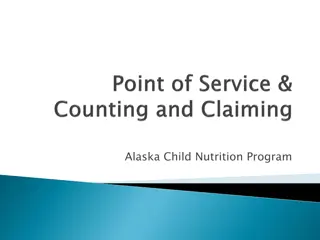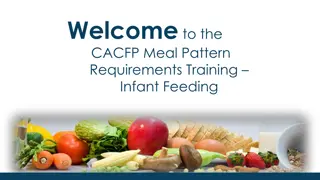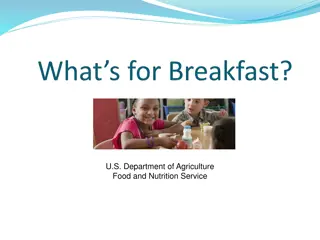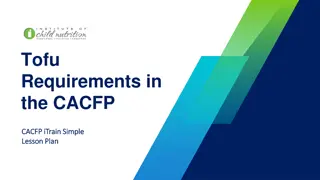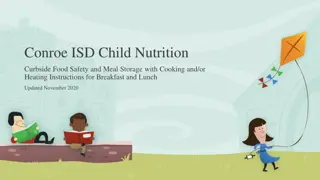Child Meal Patterns Guidance for CACFP Participants
Child Meal Patterns Guidance for Institutions in CACFP aims to ensure well-balanced meals for children, meeting nutritional needs and aligning with Dietary Guidelines. The program specifies components required for breakfast, lunch/supper, and snacks to qualify for reimbursement. Menu planners must create menus fulfilling these requirements to submit reimbursable meal invoices.
Download Presentation

Please find below an Image/Link to download the presentation.
The content on the website is provided AS IS for your information and personal use only. It may not be sold, licensed, or shared on other websites without obtaining consent from the author. Download presentation by click this link. If you encounter any issues during the download, it is possible that the publisher has removed the file from their server.
E N D
Presentation Transcript
Child Meal Patterns Guidance for Institutions Participating in the Child and Adult Care Food Program (CACFP)
Training Objectives Successfully determine whether a child s meal contains all of the meal pattern components requirements Develop two months worth of menus that include all of the CACFP meal pattern components and can be cycled throughout the year. Submit invoices for CACFP meals that are fully reimbursable
Meal Pattern Requirements CACFP meal pattern requirements assist the menu planner in providing well-balanced meals and snacks for children that: Meet nutritional needs of children Are consistent with the Dietary Guidelines for Americans Taste appetizing and contain a variety of food items (rotating foods)
Child Meal Pattern: Breakfast ALL 3 Components Required for Reimbursement: Milk (1) Fluid milk (low/nonfat for children over 2) Fruits/Vegetables (1) 100% fruit juice, fruit and/or vegetable Grain/Bread (1) Bread Cornbread, biscuit, roll, muffin Cold dry or hot cooked cereal Pasta, noodles, grains
Child Meal Pattern: Lunch or Supper ALL 5 Components Required for Reimbursement: Milk (1) Fluid milk (low/nonfat for children over 2) Fruits/Vegetables (2) 100% fruit juice, fruit and/or vegetable Grain/Bread (1) Bread Cornbread, biscuit, roll, muffin Cold dry or hot cooked cereal Pasta, noodles, grains
Child Meal Pattern: Lunch or Supper ALL 5 Components Required for Reimbursement (cont): Meat/Meat Alternate (1) Meat, poultry, fish, or alternate protein product Cheese Egg Cooked dry beans or peas Peanut, other nut or seed butters, nuts and/or seeds Yogurt
Child Meal Pattern: Snack 2:4 Components Required for Reimbursement (cont): Milk (1) Fluid milk (low/nonfat for children over 2) Fruits/Vegetables (1) 100% fruit juice, fruit and/or vegetable Grain/Bread (1) Bread Cornbread, biscuit, roll, muffin Cold dry or hot cooked cereal Pasta, noodles, grains
Child Meal Pattern: Snack 2:4 Components Required for Reimbursement (cont): Meat/Meat Alternate (1) Meat, poultry, fish, or alternate protein product Cheese Egg Cooked dry beans or peas Peanut, other nut or seed butters, nuts and/or seeds Yogurt
Required Meal Components Meat and Meat Alternates Beef, chicken, fish, ham, pork, turkey and eggs Cheese Dry beans and peas Peanut butter, almond, and other nut butters (**Caution: Allergies and Choking Hazard**) Walnuts, peanuts, almonds, soy nuts, other nuts, and seeds (**Caution: Allergies and Choking Hazard**) Yogurt Alternate Protein Product (APP)
Required Meal Components Vegetables and Fruits Mixtures (fruit salad, veg medley)=1 serving Mixed dishes with cup or more each different fruit/veg + meat/meat alternate=2 servings
Required Meal Components Fruit Juice Guidelines Must be full strength (100%) Must be pasteurized Should not be served as snack if fluid milk is the only other component being served During lunch/supper, no more than half of the vegetable/fruit component can be met with fruit juice
Required Meal Components Grains and Breads: Required component of all meals Must be made primarily of whole-grain, enriched or fortified flour or meal (first ingredient listed on package) Includes: Enriched breads, cereals, and pasta such as white bread and corn tortillas Whole Grain breads, cereals and pasta such as whole-wheat bread and ready-to-eat cereal
Required Meal Components Milk: Required component of all meals except for snack. May be served as a component of snack when the other component is not juice Not considered a serving when used as an ingredient in cooked meals
Required Meal Components Milk: Guidance for Children < 2: Children < 12 months may only be served IFIF or breast milk. If a completed medical statement is on file, they may be served milk that is 2% or less. For children 12-23 months, whole milk is recommended but not required.
Milk in the CACFP Allowable types for participants > 2 Low fat (1% or fat free) Lactose-reduced or lactose free, buttermilk or acidified milk Unflavored or flavored, including chocolate or strawberry Goat s milk (only if pasteurized) USDA-approved non-dairy milk substitutes products (e.g. some brands of soy milk) at the parent/guardian s request as long as it is nutritionally equivalent to cow s milk.
Milk in the CACFP: Substitutions Medical or Other Special Dietary Need If a participant cannot consume fluid milk due to medical or other special dietary needs (e.g. vegetarian), non-dairy beverages may be served in lieu of milk If the substitute is not nutritionally equivalent to milk (e.g. juice, water), a signed medical statement is required for the meal to be claimed.
Milk in the CACFP: Substitutions Disability If a disability directly affects a child s ability to consume milk and a signed medical statement is on file, the facility must purchase and can claim alternatives that do not conform to the meal pattern. Statement must include: Participant s disability and why it restricts participant s diet Major life activity affected by the disability Food(s) to be omitted from the participant s diet; and Appropriate substitutions
Meal Components: Substitutions Special Dietary Needs If a child has special dietary needs (e.g. vegetarian), the parent/guardian may request substitutions by submitting a written statement that includes the child s medical condition or special dietary need, listing food to be omitted and substitutions. In order to receive credit for foods outside of the meal pattern requirements, a signed medical statement must be on file.
Meal Components: Substitutions Special Dietary Needs Whether, due to a medical condition or parent preference, a substitution is needed and/or requested , the institution is not required to purchase/provide it. However, if the institution does not purchase the substitution, then they cannot claim the meal. With the exception of infants, a meal can only be claimed when: 1. It meets meal pattern component requirements or there is a medical statement with substitutions AND 2. The institution purchases and provides all components and/or substitutions.
Meal Components: Substitutions Disability If a disability affects what kinds of foods a child can consume (liquid and/or non-liquid) and a signed medical statement is on file, the facility must purchase and can claim alternatives that do not conform to the meal pattern. Statement must include: Child s disability and why it restricts child s diet Major life activity affected by the disability Food(s) to be omitted from the child s diet; and Appropriate substitutions
Family Style Meal Service Meals served in a family style setting where foods are placed on a table in serving dishes and participants serve themselves.
Family Style Meal Service Meals are able to be claimed so long as: The amount of food on table provides full required portions of each component for all participants and any supervisors Every participant is offered and encouraged to take full portion of each required meal component When a component is refused or full portion size is not taken, a supervisor actively encourages taking a full portion, or offers a 2nd helping
Child Nutrition (CN) Labels Certain foods served require additional documentation to ensure they meet the minimum component portion size requirements. Commercially processed foods used to meet the meat/meat alternate requirement Combination dishes/dishes containing more than one component **CN labels are NOT the same thing as Nutritional Facts
Child Nutrition (CN) Labels Institutions that prepare main dishes on-site must maintain documentation of: Recipes used Amount of each ingredient used in preparing the dish and estimated contribution toward meeting the component requirements Number of participants that the recipe serves **Resources: http://www.fns.usda.gov/tn/resources/foodbuyingguide. html http://www.fns.usda.gov/cnlabeling/child-nutrition-cn- labeling-program
Resource: Crediting handbook for the Child and Adult Care Food Program http://www.fns.usda.gov/sites/default/files/CACFP_cr editinghandbook.pdf


